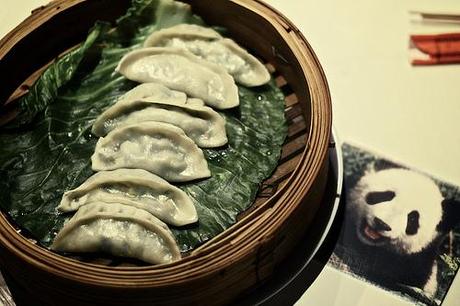
These are not mine, but they look much more pretty than mine :D
Vi avevo anticipato sommariamente in un precedente articolo sul cibo cinese e i ristoranti cinesi che ormai non ordino più i ravioli, perché quelli che faccio a casa sono più buoni di quelli “originali”. E per buoni, ovviamente, intendo che piacciono di più al mio palato, anche visto e considerato che mi è stato giustamente puntualizzato che il mio menu cinese con 5+1 portate è il menu meno cinese della storia della Cina, antica e moderna.
Ma visto che qualcuno mi ha chiesto come preparo i ravioli cinesi a casa mia, ecco in breve come li faccio.
Prima di tutto, dovete sapere che mangio solo ravioli vegetariani, anche se sono una carnivora convinta, per una mera questione di gusto. Con la carne non mi piacciono, con i gamberi muoio di soffocamento per l’allergia.
Ingredienti per la pasta: 200gr di farina 00, acqua e sale quanto basta
Ingredienti per il ripieno: le verdure che vi piacciono. Ho sperimentato che vanno più o meno bene tutte. Io in genere metto una carota, tanta verza, un porro, aglio, erba cipollina, scalogno e un cucchiaino di olio di semi.
Per preparare la pasta basta unire l’acqua alla farina, salare e amalgamare il tutto finché la pasta non è abbastanza elastica. Fate una palla e lasciatela riposare.
Per il ripieno occorre bollire le verdure come la verza (che vi servirà anche dopo) e il porro. Tagliate poi tutti gli ingredienti finemente e mettete tutto in una ciotola, di modo che si amalgamino. Se vi piace, potete aggiungere anche un po’ di pepe, ma io non lo faccio quasi mai.
Prendete poi la pasta e stendetela sul tavolo. Accertatevi che la sua consistenza non sia essere troppo sottile. Aiutatevi con un mattarello oppure con la macchinetta per le sfoglie, se ce l’avete: io la metto a 3, che è la stessa misura per la pasta dei culurgiones.
Usate un bicchiere per dare la forma tonda a ogni porzione di raviolo, poi mettete al centro un po’ di ripieno. Io uso un cucchiaino per aiutarmi con le dosi. Prendete poi il raviolo in una mano e con l’altra chiudetelo: io uso la tecnica che mi ha insegnato mia cugina per chiudere i culurgiones, ma potete usare anche la classica rotella tagliapasta, anche se il raviolo perde in estetica :P
Una volta chiusi, i ravioli sono pronti per essere cucinati. Fate bollire dell’acqua e lasciateli cucinare per qualche minuto, fino a quando non tornano a galla. Molte persone salano l’acqua come per la pasta normale, ma io in genere non la salo mai. Nel frattempo, ungo con una goccia di olio una padella larga e ci faccio saltare qualche foglia di verza tagliata a listelle. Quando i ravioli sono pronti, li faccio saltare assieme alla verza e li innaffio con un bel po’ di salsa di soia.
Io sono riuscita a mangiarne a cena una abbondante dozzina perché sono leggeri e abbastanza diregibili. E i miei ospiti mi hanno assicurato che sono ottimi :)
–
I told you briefly in a previous article on Chinese food and Chinese restaurants that I have not ordered dumplings anymore, because the ones I do at home by myself are better than the “original” chinese ones. And for “better”, of course, I mean they sounds better to my taste, even considering that I was rightly pointed out by a reader that my 5+1 Chinese dishes menu is the less Chinese menu in the entire history of China.
But since someone asked me how I prepare the chinese dumplings at home, here it comes a brief recipe. First of all, you should know that I’m eating only vegetarian dumplings although I am a convinced carnivore. It’s only only a matter of taste: I don’t like dumplings with meat, while I surely die of suffocation with the shrimp ones due to the allergy.
Ingredients for the dough: 200g of 00 flour, water and salt to taste
Ingredients for filling: all the vegetables you like. I’ve found that all vegetables are good pretty much. I generally put a carrot, a lot of cabbage, leek, garlic, chives, shallots and a teaspoon of vegetable oil.
To prepare the dough just add water to flour, salt and mix well until the dough is quite elastic. Take a ball and let it rest.
For the filling, boil vegetables such as cabbage (you will use it later as a “side order”) and the leek. Then cut all the ingredients finely and put them into a bowl, so that they can be blended. If you like, you can also add pepper, but rarely I do it.
Take the dough and roll it out on the table. Make sure that its consistency is not too thin. Help yourself with a rolling pin or with a machine for the dough, if you have it: I set it to level 3, which is the same measure for culurgiones’ pasta.
Use a glass to give the round shape to each piece of dumpling, then put a bit of filling in the middle of each shape. I use a spoon to help me with the amounts. Then take the dumpling in one hand and close it with the other hand: I use the technique to close culurgiones learnt from my cousin, but you can also use the classic wheel cutter, even though the dumplings lose in appearence: P
Once closed, dumplings are ready to be cooked. Boil water and let cook them into it for a few minutes, until they come to the surface. Many people use to salt water as they usually when they prepare pasta, but I don’t generally salt the water. Meanwhile, anointed a large frying pan with a drop of oil, and pan-fry some leaves of cabbage cut into strips. When dumplings are ready, pan-fry them along with the cabbage and wash down them with a lot of soy sauce.
I was able to to eat dozen of dumplings at dinner, as they are light and pretty much digestible. And my guests have assured me that they are delicious :)
Ti potrebbe interessare anche questo! / Posts you might be interested in
- Le 5 (+1) verità sui ristoranti cinesi / The 5 (+1) truth about Chinese Restaurants






